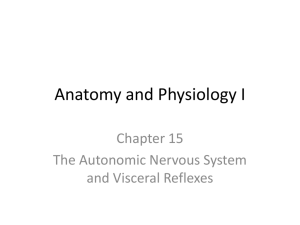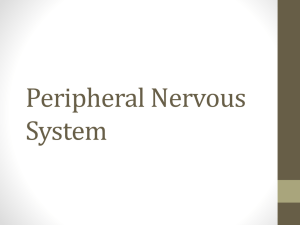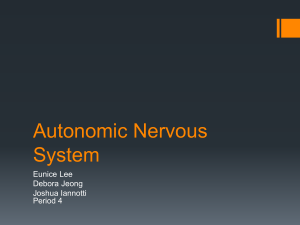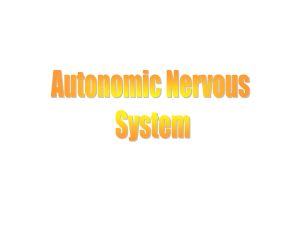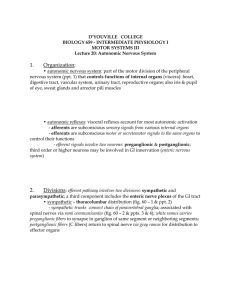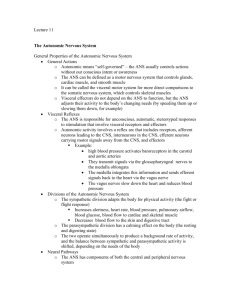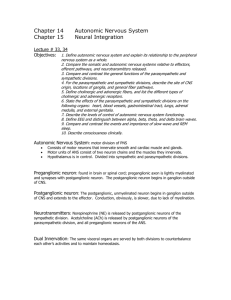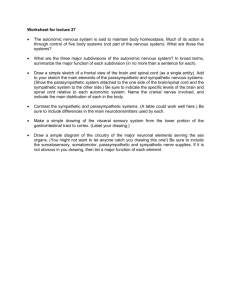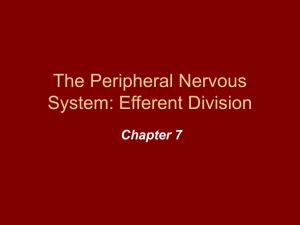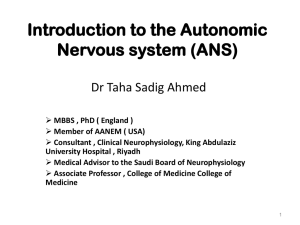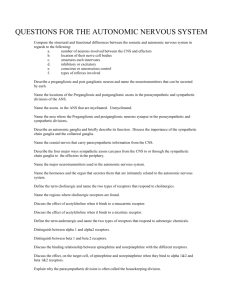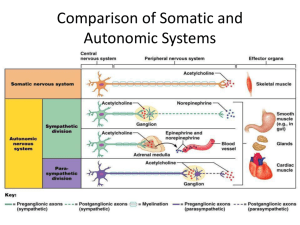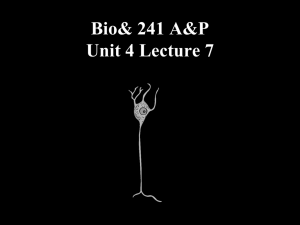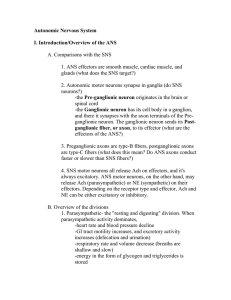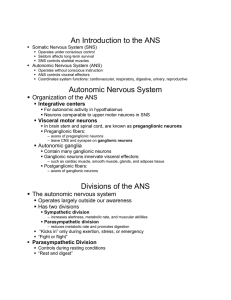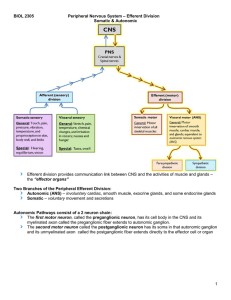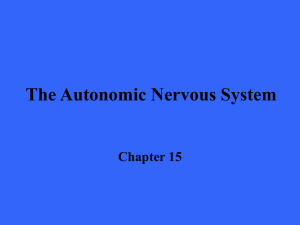The autonomic nervous system (ANS)
advertisement
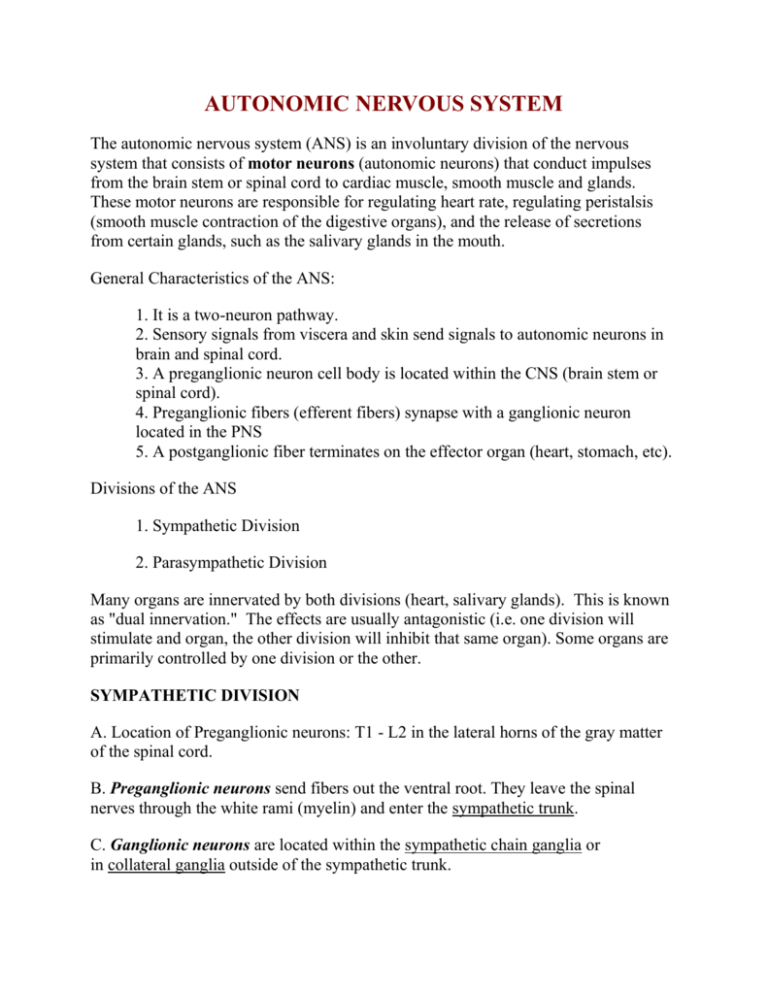
AUTONOMIC NERVOUS SYSTEM The autonomic nervous system (ANS) is an involuntary division of the nervous system that consists of motor neurons (autonomic neurons) that conduct impulses from the brain stem or spinal cord to cardiac muscle, smooth muscle and glands. These motor neurons are responsible for regulating heart rate, regulating peristalsis (smooth muscle contraction of the digestive organs), and the release of secretions from certain glands, such as the salivary glands in the mouth. General Characteristics of the ANS: 1. It is a two-neuron pathway. 2. Sensory signals from viscera and skin send signals to autonomic neurons in brain and spinal cord. 3. A preganglionic neuron cell body is located within the CNS (brain stem or spinal cord). 4. Preganglionic fibers (efferent fibers) synapse with a ganglionic neuron located in the PNS 5. A postganglionic fiber terminates on the effector organ (heart, stomach, etc). Divisions of the ANS 1. Sympathetic Division 2. Parasympathetic Division Many organs are innervated by both divisions (heart, salivary glands). This is known as "dual innervation." The effects are usually antagonistic (i.e. one division will stimulate and organ, the other division will inhibit that same organ). Some organs are primarily controlled by one division or the other. SYMPATHETIC DIVISION A. Location of Preganglionic neurons: T1 - L2 in the lateral horns of the gray matter of the spinal cord. B. Preganglionic neurons send fibers out the ventral root. They leave the spinal nerves through the white rami (myelin) and enter the sympathetic trunk. C. Ganglionic neurons are located within the sympathetic chain ganglia or in collateral ganglia outside of the sympathetic trunk. D. Postganglionic fibers leave the sympathetic trunk through the gray rami and pass through the spinal nerve again before terminating on the effector organ. E. Preganglionic fibers are short and myelinated. F. Postganglionic fibers are long and unmyelinated. H. Preganglionic fibers may: 1. Synapse with one or more neurons in the sympathetic trunk directly across from them; 2. Ascend or descend in the trunk before synapsing; 3. Pass through the sympathetic trunk and synapse with a collateral ganglion outside the sympathetic trunk; or 4. Directly stimulate the release of epinephrine and norepinephrine from the adrenal medulla. I. The sympathetic division is responsible for vasomotor (sympathetic) tone: PARASYMPATHETIC DIVISION A. Location of preganglionic neurons: Brain stem and S2, S3, and S4. B. Preganglionic fibers travel through cranial nerves III, VII, IX, and X, and spinal nerves S2-S4, and synapse with peripheral ganglia located very near or directly on the effector organ. C. Ganglionic neurons are located within peripheral ganglia. D. Preganglionic fibers are long and myelinated. E. Postganglionic fibers are short and not myelinated. F. Parasympathetic fibers do not control the diameter of the systemic arterioles but ARE responsible for peristalsis. AUTONOMIC NEUROTRANSMITTERS A. Cholinergic fibers - release ACh All preganglionic fibers release ACh (both parasympathetic & sympathetic) Parasympathetic postganglionic fibers also release ACh B. Adrenergic fibers - release NE Sympathetic postganglionic fibers release NE except those that innervate sweat glands and some blood vessels in the skin and skeletal muscles (which cause vasodilation rather than vasoconstriction) C. Actions of Autonomic NT's D. Receptors of Effectors 1. Types of Cholinergic Receptors (bind Ach): a. Nicotinic b. Muscarinic 2. Types of Adrenergic Receptors (bind NE): a. Alpha b. Beta Beta-blockers for heart patients
